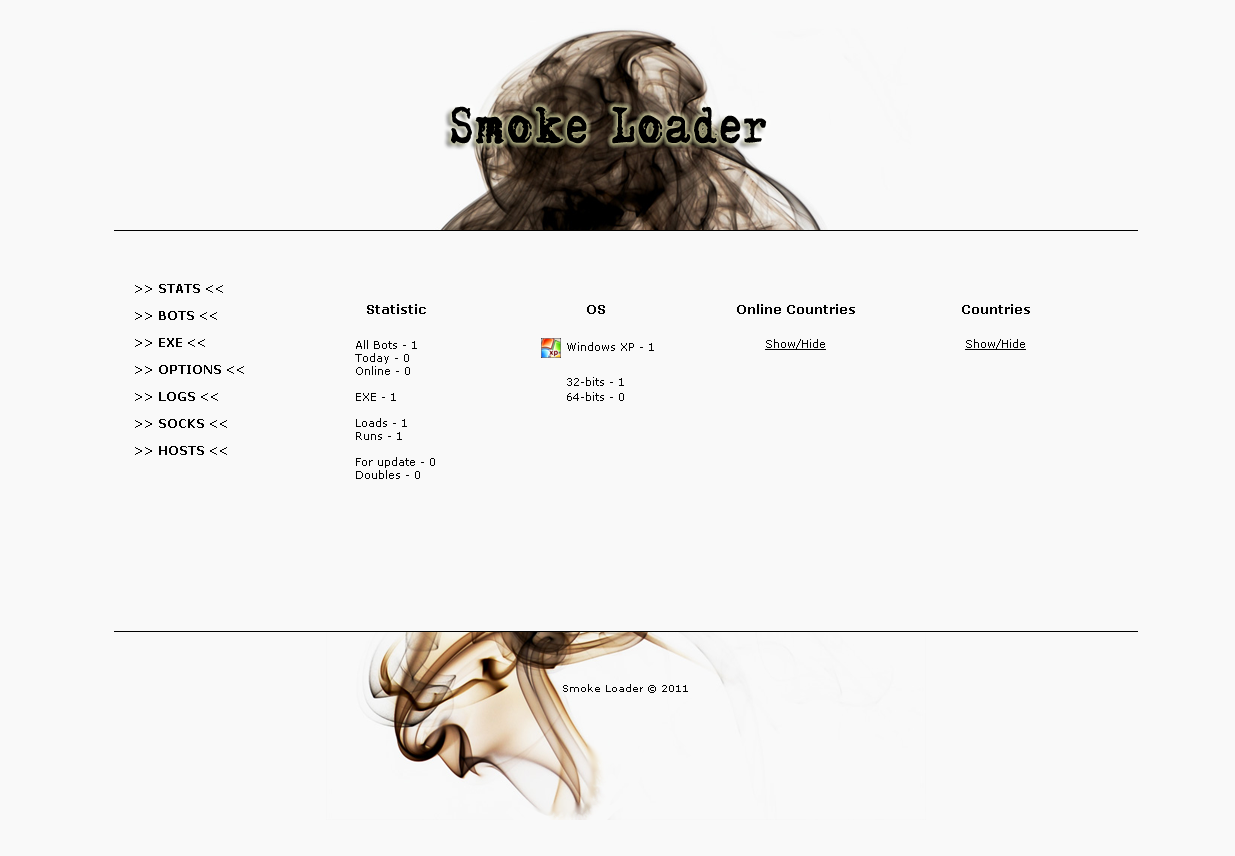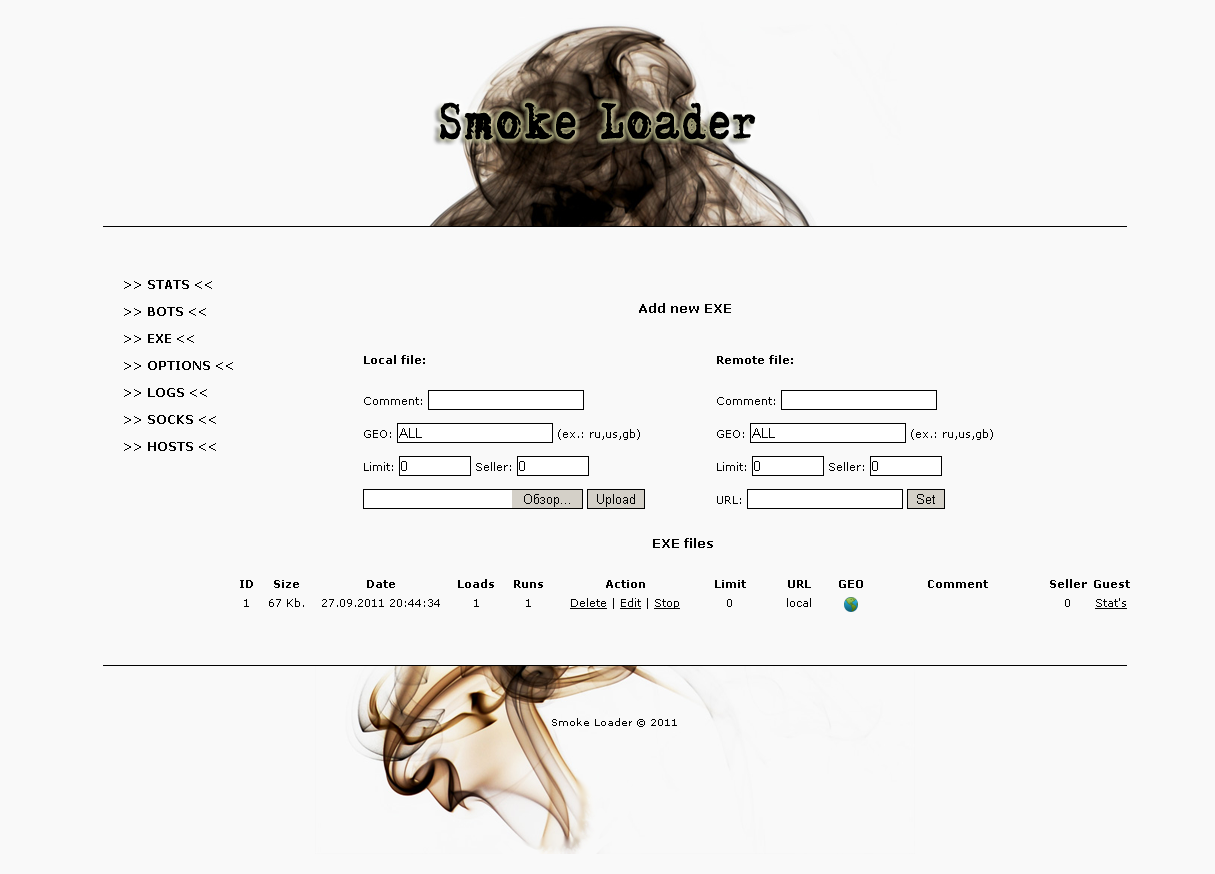The competitive arms race between security vendors and malicious cybercriminals constantly produces new defensive mechanisms, next to new attack platforms and malicious tools aiming to efficiently exploit and infect as many people as possible.
Continuing the “A peek inside…” series, in this post I will profile yet another malware loader. This time it’s the Smoke Malware Loader.
The Smoke Malware Loader is a modular malware loader, that comes with several different modules based on how much is the customer willing to spend.
Some of its features include:
– Progressive download different EXE and run *
– Geo-targeting (download only for specific countries)
– The ability to download files via a URL
– Startup and invisible work (Masked by a trusted process) **
– Detailed statistics on jobs- Self-renewal through the bot’s admin panel (locally or remotely) **
– Protection against loss by blocking bots domain **
– The small size of the loader ~ 12.6 kb ***
– Ability to use Builder for “sellers” (more accurate statistics)
– Statistics on re-launching (useful for assessing the quality of downloads, or traffic) **
– “Guest” access to the statistics- Easy kriptovka (does not contain any additional dll, overlays, etc.)
Screenshots of the command and control interface:
The modular Smoke Malware loader comes with two additional modules. The first module steals passwords from popular applications, and sends them back to the malicious attackers. The second module is a SOCKS-connection module, turning malware-infected hosts into stepping stones for anonymizing a cybercriminal’s online activities.
The first module successfully steals passwords from the following applications:
32bit FTP
BitKinex
BulletProof FTP Client
Classic FTP
CoffeeCup FTP
Core FTP
CuteFTP
Directory Opus
ExpanDrive
FAR Manager FTP
FFFTP
FileZilla
FlashFXP
Fling
FreeFTP/DirectFTP
Frigate3 FTP
FTP Commander
FTP Control
FTP Explorer
FTP Navigator
FTP Uploader
FTPRush
LeapFTP
NetDrive
SecureFX
SmartFTP
SoftX FTP Client
TurboFTP
UltraFXP
WebDrive
WebSitePublisher
Windows/Total Commander
WinSCP
WS_FTP
And from the following browsers:
Apple Safari
Flock
Google Chrome
Internet Explorer
Mozilla Browser
Mozilla Firefox
Mozilla Thunderbird
Opera
SeaMonkey
The full version of the passwords grabber also works on the following IM applications:
&RQ
AIM Pro
Digsby
Excite Private Messenger
Faim
GAIM
Gizmo Project
Google Talk
ICQ/AIM
ICQ2003/Lite
ICQ99b-2002
IM2 (Messenger 2)
JAJC
Miranda
MSN Messenger
MySpaceIM
Odigo
Paltalk
Pandion
Pidgin
PSI
QIP
QIP.Online
SIM
Trillian
Trillian Astra
Windows Live Messenger
Yahoo! Messenger
And how about the price? The price for the Smoke Malware Loader, including and excluding various modules is as follows:
– Only the loader (the non-resident version) – 150 WMZ
– Only the loader (TSR version) – 250 WMZ
– Grabber LITE – 100 WMZ **
– Grabber FULL – 150 WMZ **
– SOCKS-module – 50 WMZ (version without bekkonekta) **
– HOSTS-module – 25 WMZ **
– Rebild loader – 10 WMZ
– Update: minor fixes – for free, the rest is discussed separately
– Can build to suit your needs grabber
The modular nature of the Smoke Malware Loader allows the seller of the bot to come up with flexible pricing plans, potentially lowering down the entry barriers into this market segment. The bot’s password grabbing functionality is a great reminder of how you shouldn’t save your passwords in the browser, as they become susceptible to extraction techniques like the ones used by the Smoke Malware Loader.
Use a third-party password managing tool, like Webroot’s Password Manager for instance.
Related posts:
A peek inside the uBot malware bot
A peek inside the PickPocket Botnet
A peek inside the Cythosia v2 DDoS Bot
A peek inside the Umbra malware loader
You can find more about Dancho Danchev at his LinkedIn Profile. You can also follow him on Twitter.












